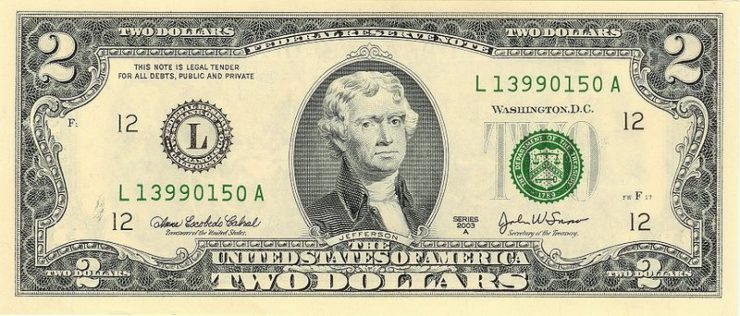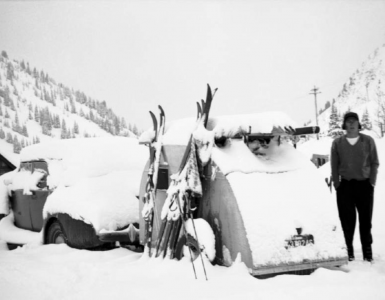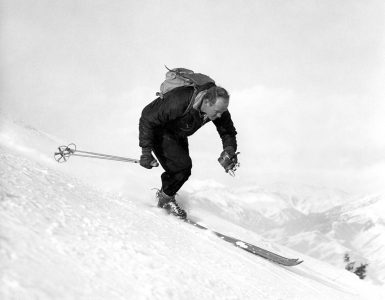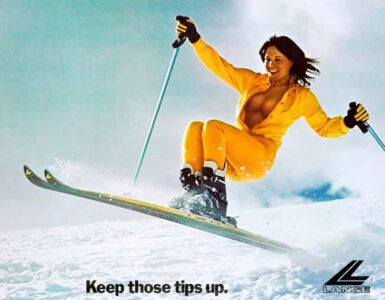By Warren Miller
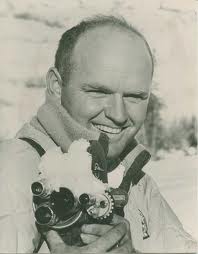
For all of you people out there who aren’t old enough to know what a rope tow is, let me describe one. Imagine a piece of rope that stretches from the bottom of the ski hill to the top. Made of hemp and usually spliced in half a dozen places, it ran endlessly around a drive wheel somewhere and dragged in the snow on the way up the hill. On the way back down, it hung loosely over half a dozen automobile wheels, each bolted to a convenient tree somewhere. As the rope dragged through the snow on the way up, it absorbed untold gallons of melted snow. Since it was made out of hemp it could absorb a lot. By mid-afternoon, the wet rope got so heavy that it took a strong skier to hold it while riding (and I use this term loosely) up.
To ride up, you stood with your skis parallel to the rapidly moving rope, held your hand out and put it around the rope, gradually increasing your grip until you started skiing up the hill at the same rate of speed as the rope. This death grip usually caused you to squeeze out a quart or more of wet, slushy, yucko water that squirted all over your ski pants and parka.
If you dared to wear just a sweater and the rope touched it, the wool would automatically get wrapped around the rope by the time you got to the top. There were no safety devices on the ropes until sometime in the 1950s, so as the rope began to climb into the shack where the automobile engine was powering it, a significant part of your sweater would continue with the rope as you fell to the ground exhausted and half naked.
You could ride a rope tow for a couple of dollars a day until you were so exhausted that you could easily fall asleep in the back of your car, where you were living in the parking lot on weekends.
Sure rope tows were wet, messy, and exhausting, but they were cheap. Anyone with a two-dollar bill could trade it for an all-day lift ticket. Some people complained, but millions of them took up skiing in the late 1940s and 1950s because it was nonstop, inexpensive, freedom. From the moment you put on your skis, you could keep them moving across the snow all day long. Racing down or riding up, it made no difference; your skis were wearing the wax off of the bottom of them all day long.
Dave McCoy was the king of the rope tows for a lot of years. I used to drive 750 long, round-trip miles on a two-lane road from Manhattan Beach to Mammoth Mountain, California to spend the weekend hanging on to one of his two rope tows. At night, you could sleep in your car or truck if you were lucky enough to have one, as I was. The friends who I hauled along with me bought my gas and paid for an oil change, but they had to sleep outside. If it was snowing, they slept under the picnic tables at the campgrounds, and if it wasn’t snowing they slept on top of the picnic tables.
Dave used to start those rope tows at eight in the morning and run them until it was too dark to ski. That was before everyone started suing everyone else for the slightest thing and added a big percentage to the cost of today’s lift ticket.
The cost of building a rope tow used to be the cost of a junkyard automobile engine, eight or 10 automobile wheels and several thousand feet of Manila hemp. The rope in those days was army surplus and could be found for as low as 10 to 15 cents a foot, which translated to about $200 for the entire length. Discounting labor, the cost of building a rope tow was less than a thousand dollars. From then on, the rope-tow entrepreneurs plowed back any rope-tow ticket earnings to eventually go into debt and build their first chairlift. Then, people were no longer tired from hanging on to a rope and they stood in long chairlift lines and complained about the wait.
The reality of economics has forced a lot of change in the ski industry as it has in all industries, but I know that those rope tows sure opened up a lot of opportunities for me to make funny movies of people trying to hang on to them. It also allowed me to learn how to ski at a price I could afford while I was starting my ski-film business.
Don’t get me wrong. I’m not complaining about the advent of chairlifts. I enjoy that relaxing ride, but I had just as much fun on the mountain when a rope pulled me to the top.



